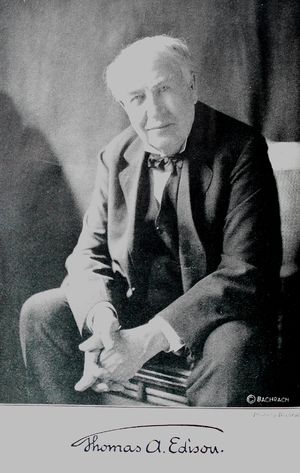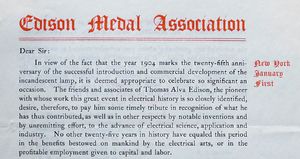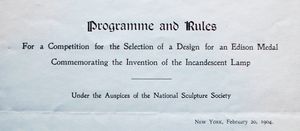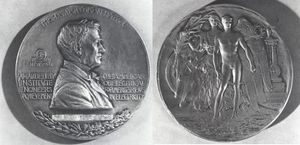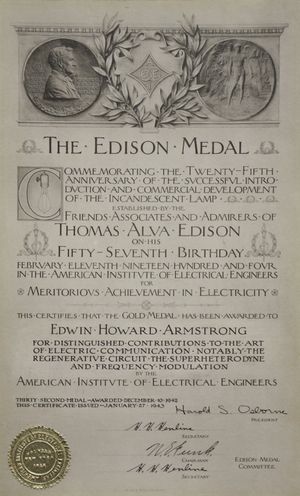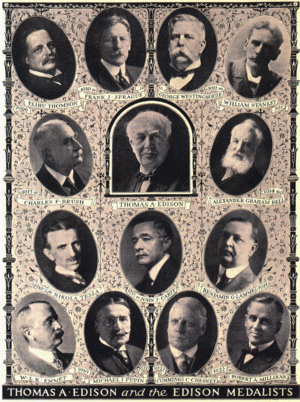IEEE Edison Medal
Origins of the Edison Medal on its 100th Anniversary: Introduction
The Edison medal is the most prestigious award given in the United States and
Canada recognizing meritorious accomplishments in the fields of electronics and
electrical engineering. The year 2009 marks the 100th anniversary of the medal
named in honor of America's most famous inventor, Thomas Alva Edison. Edison's
work exemplifies the development of large scale industrial research laboratories,
the creation of new technology and the installation of the first complete
electrical systems in the 19th century. Over its history, many of the most
important contributors to the development of electronics have been presented the
Edison Medal in recognition of their critical roles in laying the foundations of
the modern electrical world. This article presents the story of the Edison Medal,
its origins and its legacy of honor.
Edison at the Turn of the Century
By the end of the 19th century, Thomas Alva Edison had achieved fame, wealth and
notoriety. He was known as the "Wizard of Menlo Park" for the many inventions that
originated from his research laboratory in New Jersey; including the
phonograph and electric light. In 1886, Edison relocated to a new,
larger facility in West Orange, New Jersey. A small laboratory was also set up in
1886 at his new summer home in Fort Myers, Florida. Increasingly, he focused his
attention on refining the phonograph and on his new film and motion picture
businesses. Edison's work on the alkaline battery and his Portland cement
operations also looked promising. The 1903 release of the film The Great Train
Robbery put Edison into the headlines again. Edison's list of accomplishments
was well established, and he was a household name in America and in Europe. His
long standing and well publicized feud with George Westinghouse and [[Nikola
Tesla]] over the effectiveness of alternating versus direct current did not seem
to diminish his public image. And, by the opening years of the 20th century, those
battles too were subsiding.[1]
Origins of the Edison Medal
1904 barked the 25th anniversary of the Edison incandescent lamp. Samuel Insull,
Charles Batchelor and a group of Edison's friends, former employees and
associates decided to commemorate the anniversary on the occasion of Edison's
birthday.[2] Edison, 71, Honored By Old Associates. The first meeting
of the Executive Committee formed to organize the event were held in December 1903
as the group rushed to prepare for Edison's February 11, 1904 birthday.[3]
The Executive Committee quickly prepared a circular to solicit contributions. The
circular, dated January 1, 1904, identified Samuel Insull as the Chairman and
Charles Batchelor as Vice-Chairman of the Edison Medal Association. It also
named the 30 member Executive Committee and 124 additional members of the Edison
Association. Among the notables identified were J. Pierpont Morgan, [[Reginald A.
Fessenden|R.A. Fessenden]], W.S. Mallory, Frank Sprague and
Nikola Tesla. The group planned to name an endowed academic medal after Edison
that would be awarded through the American Institute of Electrical Engineers (AIEE). The AIEE would act as trustee of the medal.
The Edison Medal Association intended to raise $7,000 to fund the medal and
expenses of the association, of which $5,000 would represent the principal balance
of the endowment. Annual interest on the balance would fund future expenses and
annual awards. The Executive Committee set an impossibly short time frame of only
30 days to solicit subscriptions. [4]
The Executive Committee faced logistical difficulties in completing all their
preparations before the February celebration. The selected the National Sculpture
Society to assist with the medal design; but, at the close of January 1904, the
subcommittees responsible for the medal design had not selected an appropriate
image of Edison or decided on a sculptor for the Medal.[5] Given the impending date
of the celebration, the Committee decided it would formally present the legal
agreement establishing the Edison Medal and convey the trusteeship of the Edison
Medal to the AIEE without presenting the medal itself.[6] The Committee rushed to draft their
Deed of Gift ("Deed") over the next three weeks.
The Deed and corresponding rules governing the Edison Medal specified that the
Edison Medal Association would annually recognize a student graduating from any
U.S. or Canadian university or military academy who presented the best thesis on
an original topic about theoretical applied electricity and magnetism. Competition
was restricted to no more than two students from any one institution. Each student
had to complete at least two years of residence and coursework at the university
and be no older than 25 years of age. The thesis was restricted to 6,000 words
(approximately 20 typed pages). The award would be presented annually on Edison's
birthday, February 11. The Deed also specified that the Edison Medal Association,
under the auspices of the National Sculpture Society, would host a competition to
finalize the medal's design after Edison's birthday.[7][8]
Edison Celebration
Five hundred people attended the commemorative dinner on February 11, 1904
celebrating Thomas Edison's 57th birthday and the 25th anniversary of the Edison
incandescent light. The affair was held at the Waldorf Astoria Hotel in New York.
Addresses were made by the [[Presidents of the American Institute of Electrical
Engineers (AIEE)|President of the AIEE]], B.J. Arnold, and
A.E. Kennelly of Harvard University, C.F. Brackett of
Princeton University, Joseph McCall and C.L. Edgar. Samuel Insull presented the
Deed of Gift inaugurating the Edison Medal. [9][10]
Edison sat under a display of flags and 57 electric lamps. According to eyewitness
accounts, he was reserved in public and too modest to speak. Sugar models of his
inventions were placed on tables in front of him. Edison's original telegraph key
and quadruplex sender sat on the table in front of Edison positioned at his right
hand. Wires stretched across the room to a Marconi wireless transmitting
apparatus. Thousands of electric bulbs were strung along the galleries. Over one
hundred waiters served ices "contained in models of motors, phonographs,
switchboards, automobiles, incandescent apparatus, dynamos, megaphones, and
batteries, the ices themselves being in the form of incandescent bulbs." Each
guest went home with a small ivory box with a woman bearing a light and inscribed
"Genius with the Lamp" or a miniature incandescent lamp pin. The menus included a
picture of a bronze bust of Edison with the words "The Wizard" with Edison's
autograph below the image.[11][10]
Congratulatory messages were received from notables around the world. Andrew
Carnegie called Edison the "King of Telegraphers". President Theodore Roosevelt
congratulated Edison "as one of those Americans to whom America owes much..." Lord
Kelvin cited his "gratitude to Edison [for his] useful and well worked-out
inventions for the public". Finally, Edison's own message of thanks was read
aloud. It stated, in part, "...Your expressions of goodwill gratify me
greatly...This medal is founded to encourage young men to devote their best
thought and work to electrical development. I rejoice in this stimulus to harder
study...God bless them and you, my dear friends, and this American Institute of
Electrical Engineers."[11]
The highlight of the evening occurred with Edison telegraphed "73 -
Congratulations and best wishes" on his original quadruplex telegraph instrument.
The message was carried across the wires and broadcast by the Marconi wireless
equipment.[10][11] Samuel Insull, Chairman
of the Edison Medal Association, then formally presented the Deed of Gift to
Professor Arthur Kennelly who received it on behalf of the
AIEE.
The Medal's First Years
The medal was intended to "serve as an honorable incentive to the youth of America
to maintain by their works the high standard of accomplishment by the illustrious
man whose name and features shall live while human intelligence continues to
inhabit the world."[8] The annual student award was to
include a parchment certificate and a gold medal funded by the annual interest
earnings on the gift. Unfortunately, after the 104 celebration, little progress
was made.
The gift fund was deposited with the Continental Trust Company of New York. But
three years passed and no medals were awarded. In February 1907, the Edison Medal
Committee appointed a subcommittee "to propose a statement of the difficulties
that the Committee had experienced in obtaining competitors for the medal under
the present Deed of Gift and to recommend to the Medal Committee such
modifications...as might seem proper in their judgment under the circumstances."
The John Fritz Medal
Meanwhile, as the Edison Medal languished, the John Fritz Medal, the highest
American award in the engineering profession, was being presented each year.
Established in 1902, it recognized scientific or industrial achievement in any
field of pure or applied science. Fritz had achieved fame and recognition for his
development of American iron and steel manufacturing. The John Fritz Medal was
established on Fritz's 80th birthday by the American Institute of Mining Engineers
(AIME), the American Society of Civil Engineers (ASCE), the American Society of
Mechanical Engineers (ASME), and the American Institute of Electrical Engineers
(AIEE).[13]
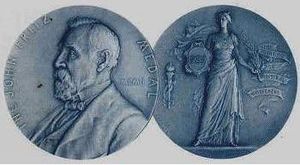
The Fritz Medal eventually included the American Association of Engineering
Studies (AAES) as well, and rotated among all five engineering societies that made
up the successor organizations. The first four Fritz Medals were given to John
Fritz (1902), Lord Kelvin (1905), George Westinghouse (1906) and [[Alexander
Graham Bell]] (1907).
Thomas Edison received the fifth Fritz Medal in 1908 for
his "invention of the duplex and quadruplex telegraph; the
phonograph; the development of a commercially practical
incandescent lamp; the development of a complete system of electric lighting,
including dynamos, regulating devices, underground system protective devices and
meters."[14]
Edison Medal Restructured
In 1908, the Executive Committee of the Edison Medal Association now decided to
revamp its medal's rules and intended purpose. Arthur Kennelly later explained that between 1904 and 1908 a shortage of applicants led
to the absence of qualified candidates under the existing rules which focused the
award on student recipients.[15] The Committee responded by redefining the
medal's purpose and executed an Amended and Substitute Deed of Gift Creating The
Edison Medal ("Amended Deed') in New York on March 26, 1908.[16]
The new deed re-established the Edison Medal in partnership with the New York
Trust Company and the American Institute of Electrical Engineers (AIEE). It
reasserted that the medal "should, during the centuries to come, serve as an
honorable incentive to scientists, engineers and artisans to maintain by their
works the high standard of accomplishment set by the illustrious man whose name
and features shall live while human intelligence continues to inhabit the world."
The Amended Deed also re-wrote the rules and established that the AIEE would
present the medal as its award for "...MERITORIOUS ACHIVEMENT [emphasis in
document] in Electrical Science or Electrical Engineering or the Electrical Arts,
whenever in the judgment of said Committee [there is someone] properly deserving
of such award..."[17] Revisions to the Committee's bylaws commenced
in October 1908, and the final draft was presented to the Board of Directors on
December 11, 1908.[18] The Board approved the minutes on May 18, 1909, making operative the
revised by-laws and new rules.[19] Later, the AIEE appointed a jury of 24 members to select the recipient
of the award.[15]
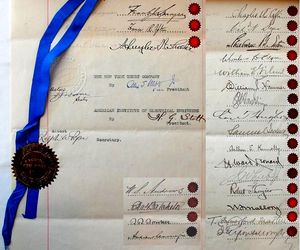
A Design for the Medal
The 1904 Edison Medal Committee had initiated a Programme and Rules governing its
competition to select an appropriate design for the medal.[20] Working under the auspices of the National Sculpture Society, designs
were invited within a general scheme that specified Thomas Edison's portrait would
dominate the face of the medal and an allegorical design would appear on the
reverse side. Edison's image would date from the time of his incandescent light,
approximately 25 years earlier. A prize of $1,000 would be awarded to the selected
artist for production of the medal. Designs were due from April 25-30, 1904, with
a decision to be rendered within one month. The jury for the competition included
Daniel C. French[21], Augustus Saint Gaudens[22] and J.Q.A. Ward[23] of the National Sculpture Society and Edward Adams and
T. Commerford Martin on behalf of the Edison Medal
Association.[20]
The design contest was administered late in 1904, and on Nov. 11, 1904, James
Earle Fraser[24], a New York sculptor and medallion designer,
was informed by St. Gaudens that he was the unanimous selection of the jury. St.
Gaudens asked Fraser to provide several sketches "showing modifications to your
present idea, or of new ones that may occur".[25]
The final design featured both Edison and an allegorical symbol of merit. The
obverse (face) features Edison's portrait and is inscribed "Awarded By The
American Institute of Electrical Engineers for Meritorious Achievement In
Electricity". The reverse (back) depicts "The Genius of Electricity Crowned by
Fame" showing an angel standing behind a male nude and a glowing Edison light
sitting on a pedestal.[26][27][25] The Amended Deed specified that the
AIEE would retain a die for future production and reproduction of the gold
medal.[17]
First Recipient in 1909
Prior to issuing the Amended Deed which redefined the Edison Medal, five graduate
students who had qualified to compete for the medal under the old 1904 rules had
submitted their theses. Since the medal had been restructured to focus on lifetime
achievement instead of student work, the five candidates were asked to withdraw
from the medal competition in 1908. They were allowed to resubmit their theses in
a special contest to receive a Diploma of Merit plus a $150 cash award issued by
the AIEE.[18] On May 18, 1909, Trygve Jensen, a graduate
student at the University of Illinois, won the Diploma of Merit for his research
on the "Operation of a 100,000 Volt Transformer."[19]
Finally, five years after the initial 1904 organization of the Edison Medal
Association, the Committee was ready to officially name its first Edison Metal
recipient.[28] Dr. Elihu Thomson was cited for his "meritorious
achievement in electrical science, engineering and arts as exemplified in his
contributions thereto during the past 30 years."[19] [29] Thomson's accomplishments
included approximately 700 patents, work on electric arc lighting, establishing
the Thomson-Houston Electric Company (which would eventually merge with the Edison
General Electric Company to become General Electric Company), the Thomson Electric Meter, alternating current devices, the electric
air drill, and methods of electric arc welding. In the 1890s, Thomson investigated
X-rays and performed research on fused quartz for use in reflecting astronomical
telescopes. Thomson was active in the AIEE, contributed to many other societies
and received the John Fritz Medal in 1916. He later become the President of the
Massachusetts Institute of Technology.[30] The
Edison Medal Association presented Thomson with a parchment certificate
constituting official notice of the award at the AIEE's annual dinner on February
24,1910. He received the gold Edison Medal at the AIEE's annual meeting on May
17.[19]
Conflicts and Controversy
The Edison Medal has been awarded annually since 1909 with the exception of 1915,
1926, 1964 and 2003. The 1926 medal was actually rejected by the named recipient,
Dr. William Coolidge, who refused to accept the medal in light of a U.S.
Circuit Court decision invalidating his patent on ductile-tungsten. The decision
stated that a patent (for an invention) could not be awarded for a scientific
discovery. The Edison Medal Committee still tried to award the medal, but Dr.
Coolidge refused to "detract from the luster of that medal which should stand as
one of the most coveted prizes for meritorious work in the electrical field."[31]
Ironically, most of the Edison Medal awards in its first ten years went to
pioneers or supporters of alternating current and arc lightning technologies even
though Edison's long standing opposition to alternating current systems was well
known and had garnered many newspaper headlines.[32][33] The rules did not require Edison to present the award, and he
was not involved with the award committee's selection of recipients. The following
innovators of alternating current technology received Edison Medals during its
first decade: Elihu Thomson (1909), Frank Sprague (1910),
George Westinghouse (1911), William Stanley (1912), [[Charles F.
Brush|Charles Brush]] (1913), Nikola Tesla (1916) and Michael Pupin
(1920).[28]
George Westinghouse received the 1911 Edison Medal for his groundbreaking work
developing alternating current systems for power distribution and lighting. After
nearly 25 years of battling Westinghouse over the alternating current versus
direct current systems, Edison offered Westinghouse no congratulations at the
ceremony.[33] Westinghouse ignored
Edison stating that "If I have had any success in life it has been due to my
wife."[32]
In 1917, the Edison Medal was presented to another former Edison rival, [[Nikola
Tesla]], for his development of polyphase and high frequency electric
currents.[34][35] Rumors had circulated in 1915 that both Tesla and Edison might
jointly share the Nobel Prize in Physics. Though unconfirmed by the Nobel
Committee, Tesla allegedly rejected the award and would have nothing to do with
Edison. Contradictory stories followed. Soon thereafter, the 1915 Nobel Prize
was presented to two British scientists.[36]
The following year, the Edison Medal Association selected Tesla as its 1916 medal
recipient. Although Tesla was listed on the original 1904 Edison Medal General
Committee subscription[4], he was now unwilling to receive an
award named after Edison. Tesla further thought that his contributions to
wireless telegraphy and radio had been slighted
since Guglielmo Marconi had already received the Nobel Prize in 1909 with
Carl F. Braun. Tesla initially refused the nomination in anger, but later agreed
to accept the Edison Medal after his friends at the AIEE pled with him to overcome
years of hostility, bitterness, and competitive rivalry with Edison. [37] Tesla stunned the audience at the presentation ceremony
when he graciously accepted the award and complimented Edison, who did not attend
the ceremony, as "this wonderful man, who had had no theoretical training at all,
no advantages, who did all himself, getting great results by virtue of his
industry and application."[15]
Tesla treasured the Edison Medal during his final years. Poverty stricken, he gave
up virtually all of his personal possessions, but kept the medal in a safe at his
subsidized Hotel New Yorker apartment. Tesla is reported to have proudly shown the
medal to many visitors. After his death on January 7, 1943, Tesla's nephew opened
the safe to discover that the medal was missing. It has never been recovered. [37][38][39]
The Edison Medal for 1947 was presented to Lee De Forest by none other than
David Sarnoff, President of the powerful [[RCA (Radio Corporation of
America)|Radio Corporation of America (RCA)]] and a one-time litigant both with
and against De Forest over patent rights. Sarnoff heaped glowing praise on De
Forest's grid-controlled electron vacuum tube as
"one of the twenty great inventions of all time".[40]
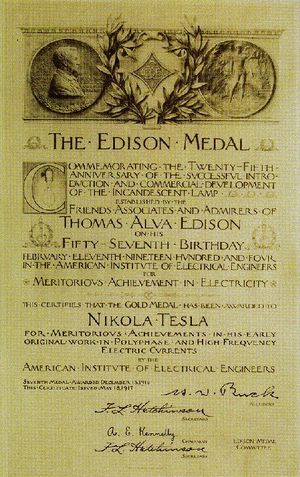
Connections
The Edison Medal Winners are well represented among the recipients of the John
Fritz Medal, and many were also members in the most prestigious national
engineering honor society in the U.S., Tau Beta Pi. Of the 1903 John fritz Medal
winners from 1902-2008, 52 are also Tau Beta Pi members. Of the 13 people that won
both the John Fritz Medal and the Edison Medal, six were Tau Beta Pi members.
These include Michael Pupin (who won the Edison Medal in 1920), [[Frank B.
Jewett|Frank Jewett]] (1928), Vannevar Bush (1943), [[Charles F.
Kettering|Charles Kettering]] (1958), Walker Cisler (1965) and George Brown
(1967). The remaining medalists include Elihu Thomson (1909), [[Frank J.
Sprague|Frank Sprague (1910)]], George Westinghouse
(1911), Alexander Graham Bell (1914), John Carty (1917),
Willis Whitney (1934) and Philip Sporn (1945).[41]
The Edison Medal was awarded to a number of people for their critical roles in
developing radio and television communication, including Michael Pupin (1920)
for his work in mathematical physics and its application to the electric
transmission of intelligence; Frank Conrad (1930) for radio broadcasting and
short wave radio transmission; Arthur Kennelly (1933) for
the theory of electrical transmission and international electrical standards;
Edwin Armstrong (1942) for the regenerative,
super-regenerative and super-heterodyne circuits and
frequency modulation FM radio; Lee De Forest (1946) for the
grid-controlled vacuum tube; and Vladimir Zworykin (1952) for the
Armstrong and Millikan
Edwin Armstrong was particularly introspective upon his
receipt of the 1942 Edison Medal after his many years spent in litigation with
over radio patents and public acknowledgement of who invented various radio
circuits. The AIEE awarded Armstrong an honorary lifetime membership (the first of
which had been extended to Lord Kelvin in 1892) together with the Edison Medal.
Armstrong's Edison Medal citation noted the importance of his work stating, "This
keystone of radio development was later to become involved in fourteen years of
litigation and which, in the end, was decided by lay courts based on errors of
fact and judgment which were contrary to the scientific facts."[42]
Alan Hazeltine presented the award to Armstrong stating "...one development
stands out from all the others... the application of the three-electrode vacuum
tube... the original electronic tube was the two-electrode vacuum tube of Edison,
in whose honor the Edison Medal was established. Others subsequently applied the
"Edison Effect" in radio detection [but] the real foundation for the unlimited
development was laid by the Edison Medal recipient, Dr. Edwin Howard Armstrong."
Armstrong's acceptance speech began, "It is not possible for me to find the words
to tell you what this honor means to me. To have belonged to the generation which
learned the meaning of volts and amperes when Edison was at the height of his
career, to be able to follow in the footsteps of my old instructor - [[Michael
Pupin]] - who stood here twenty-two years ago, and to have my own work appraised,
during these difficult days, as worth of the Edison Medal, gives it an inspiring
meaning that can never be described." [44]
In 1922, Robert Millikan won the Edison Medal "for his
experimental work in electrical science". He was the first recipient to be honored
primarily for scientific contributions rather than engineering or invention. The
selection committee is rumored to have been influenced by his leading role in the
mobilization of science and engineering to carry out military research during
World War 1. The award proved timely, since the following year he received the
Nobel Prize in Physics, becoming the first and only Edison Medalist to win
this prestigious recognition. [45][46]
Edison's 1928 Congressional Medal
Thomas Edison is revered as one of the great American
inventors. He is recognized in the applied fields of industrial research,
engineering and electronics for his many inventions and in science for his
discovery of the "Edison Effect". Edison was long recognized as holding the
largest number of U.S. parents awarded to any American, eventually obtaining 1,093
patents.[47] The U.S. Congress presented Edison with a gold
medal in 1928, three years before his death, for "development and application of
inventions that have revolutionized civilization in the last century."[48] Among those present to witness President
Coolidge's presentation of the Congressional Medal were Dr. Elihu Thomson, the
Edison Medal's first recipient, and the first chairman of the Edison Medal
Association, Samuel Insull.[49]
The Legacy of the Edison Medal
In 1963, the Institute of Radio Engineers (IRE) and the
AIEE] [[Formation of IEEE by the Merger of AIEE and
IRE|merged to form the Institute of Electrical and Electronics Engineers (IEEE)]].
The IRE's former Medal of Honor, its highest award first
given to Edwin Armstrong in 1917, was selected to be the
IEEE's "highest award". The Edison Medal was selected to become the IEEE's
"principal medal".[50] Its purpose
remains the same today as in 1909. As Arthur Kennelly
stated over seventy years ago, the Edison Medal was intended to identify those
"great and noteworthy" and those "great and notorious and worthy of merit",
serving as a "Who's Who" in the field of electronics and electrical
engineering.[15]
Today, the Edison Medal is the oldest award in the areas of electrical and
electronics engineering. Samsung Electronics Co., Ltd. agreed to sponsor the IEEE
Edison Medal in 2006 and is committed to the sponsorship through 2016.[51] The Edison Medal
is considered the highest American award "for a career of meritorious achievement
in electrical science, electrical engineering or the electrical arts."[52][35]
Nominations and the selection of award recipients are governed by the IEEE Medals
Council of the IEEE Awards Board. The award is based on "leadership,
individual contributions, originality, breadth, patents/publications, other
achievements, honors, duration of dominance, quality of nomination."[35][53]
The original award included a gold medal, bronze replica, small gold replica,
certificate and honorarium.[54] Today's prize
includes a $10,000 honorarium, gold medal, gold pendant and certificate.[51]
The 2009 Edison Medal was awarded to Tingye Li, a retired division manager of the
Communications Infrastructure Research Laboratory at the AT&T Laboratories in
Holmdel, New Jersey.[35] His work in the field of broadband
optical fiber communications seems far removed from Thomas Edison's incandescent
light first commemorated by Edison's friends and associates 105 years ago. The
tremendous progress achieved in electronics and electrical science of the past
century, which is characterized by the recipients of the Edison Medal, has made it
a living testament to the life and work of its namesake, Thomas Edison.
Original Article
A .pdf of Bart's original article, originally appearing
in The Antique Wireless Association Review, Volume 22, 2009
List of Edison Medal Winners
- Elihu Thomson, 1909
- Frank J. Sprague, 1910
- George Westinghouse, 1911
- William Stanley, 1912
- Charles F. Brush, 1913
- Alexander Graham Bell, 1914
- Nikola Tesla, 1916
- John J. Carty, 1917
- Benjamin G. Lamme, 1918
- W. L. R. Emmet, 1919
- Michael I. Pupin, 1920
- Cummings C. Chesney, 1921
- Robert A. Millikan, 1922
- John W. Lieb, 1923
- John W. Howell, 1924
- Harris J. Ryan, 1925
- William D. Coolidge, 1927
- Frank B. Jewett, 1928
- Charles F. Scott, 1929
- Frank Conrad, 1930
- E. W. Rice, Jr., 1931
- Bancroft Gherardi, 1932
- Arthur E. Kennelly, 1933
- Willis R. Whitney, 1934
- Lewis B. Stillwell, 1935
- Alex Dow, 1936
- Gano Dunn, 1937
- Dugald C. Jackson, 1938
- Philip Torchio, 1939
- George A. Campbell, 1940
- John B. Whitehead, 1941
- Edwin H. Armstrong, 1942
- Vannevar Bush, 1943
- E. R. W. Alexanderson, 1944
- Philip Sporn, 1945
- Lee de Forest, 1946
- Joseph Slepian, 1947
- Morris E. Leeds, 1948
- Karl B. McEachron, 1949
- Otto B. Blackwell, 1950
- Charles F. Wagner, 1951
- Vladimir K. Zworykin, 1952
- John F. Peters, 1953
- Oliver E. Buckley, 1954
- Leonid A. Umansky, 1955
- Comfort A. Adams, 1956
- John K. Hodnette, 1957
- Charles F. Kettering, 1958
- James F. Fairman, 1959
- Harold S. Osborne, 1960
- William B. Kouwenhoven, 1961
- Alexander C. Monteith, 1962
- John R. Pierce, 1963
- Schedule revised, 1964
- Walker L. Cisler, 1965
- Wilmer L. Barrow, 1966
- George H. Brown, 1967
- Charles F. Avila, 1968
- Hendrik W. Bode, 1969
- Howard H. Aiken, 1970
- John W. Simpson, 1971
- William H. Pickering, 1972
- B. D. H. Tellegen, 1973
- Jan A. Rajchman, 1974
- Sidney Darlington, 1975
- Murray Joslin, 1976
- Henri Busignies, 1977
- Daniel E. Noble, 1978
- Albert Rose, 1979
- Robert Adler, 1980
- C. Chapin Cutler, 1981
- Nathan Cohn, 1982
- Herman P. Schwan, 1983
- Eugene I. Gordon, 1984
- John D. Kraus, 1985
- James L. Flanagan, 1986
- Robert A. Henle, 1987
- James Ross Macdonald, 1988
- Nick Holonyak, Jr., 1989
- Archie W. Straiton, 1990
- John Louis Moll, 1991
- G. David Forney, Jr., 1992
- James H. Pomerene, 1993
- Leslie A. Geddes, 1994
- Robert W. Lucky, 1995
- Floyd Dunn, 1996
- Esther M. Conwell, 1997
- Rolf Landauer, 1998
- Kees A. Schouhamer Immink, 1999
- Jun-ichi Nishizawa, 2000
- Robert H. Dennard, 2001
- Ed Hammer, 2002
- No Award, 2003
- Federico Capasso, 2004
- Peter Lawrenson, 2005
- Fawwaz T. Ulaby, 2006
- Russell D. Dupuis, 2007
- Dov Frohman-Bentchkowsky, 2008
- Tingye Li, 2009
References
- ↑ The "War of Currents", or "Battle of
Currents", raged from the mid-1880s through the first years of the twentieth
century. George Westinghouse and Thomas Edison became bitter adversaries due to
Edison's ruthless promotion of direct current (D.C.) for electric power
distribution over the alternating current (A.C.) systems advocated by Westinghouse
and Nikola Tesla The battle was waged in newspapers, the courts and through
various banking and business dealings. Contracts for major lighting and power
installations such as the Columbian Exposition and propaganda over the first
electric chair provided the public with numerous newspaper headlines.
Jonnes, J. (2003). Empires of Light: Edison, Tesla, Westinghouse, and the Race to Electrify the World. New York: Random House, Inc.
McNichol, T. (2006). AC/DC: The Savage Tale of the First Standards War. San Francisco: Jossey-Bass. - ↑ A number of these former employees and associates of
Edison would later form the Edison Pioneers in 1918. This group was established to
memorialize Edison through public works including preserving Edison artifacts and
historic places, funding scholarship medals and building memorials. The group met
annually on Edison's birthday. The original Edison Pioneers included 28 members
and 230 former associates of Edison. The following are noted in
particular:
(1) Edison's 'four principal assistants': Charles Batchelor (Chairman of the Edison Medal Assn.), Edward Johnson, John Kruesi and Francis Upton (Edison Medal Assn.);
(2) Edison's 'co-workers': Charles Edgar (Edison Medal Assn.), William Hammer (Edison Medal Assn.), Samuel Insull (Executive Committee of Edison Medal Assn.), Frances Jehl (Edison's assistant at Menlo Park and his biographer), Robert Lozier (Edison Medal Assn.), T. Commerford Martin (Edison Medal Assn. and editor of Electrical World), John Ott (Edison Medal Assn.);
(3) Edison's 'associates': Richard Bowker (Edison Medal Association), Henry Ford (founder of the Edison Institute later known as the Henry Ford Museum and Greenfield Village); Arthur Kennelly (awarded Edison Medal in 1933), Frank Sprague (awarded Edison Medal in 1910), Nikola Tesla (awarded Edison Medal in 1916) and Theodore Vandeventer.
New York Times Article Archives. New York Times Internet Site. See http://www.nytimes.com/ref/membercenter/nytarchive.html. (1918, Feb. 12).
Hammer, W.J. (1920, March 31). Letter from W.J. Hammer to F. Jehl. Smithsonian Institution, National Museum of American History Archives Center, William J. Hammer Collection. Rutgers University Thomas A. Edison Papers Digital Edition Internet Site. Document X098A, X098A082; TAEM 0:0. See http://edison.rutgers.edu/digital.htm.
Miller, F.T. (1931). Thomas A. Edison, Benefactor of Mankind. Chicago: John C. Winston Company.
Kennelly, A.E. (1932). Biographical Memoir of Thomas Alva Edison 1847-1931. National Academy of Sciences Biographical Memoirs. Vol. XV, 10th Memoir. Presented at National Academy of Sciences Autumn Meetings, 1932.
Edison Pioneers. (2009, April 28). Wikipedia Internet Site. See www.wikipedia.org. - ↑ Documents. Edison Medal Association. Collection of David & Julia Bart. Minutes of Executive Committee Dec. 23 and 30, 1903
- ↑ 4.0 4.1 Documents. Edison Medal Association. Collection of David & Julia Bart. (1904a, Jan. 1). Edison Medal Association Subscription and Form.
- ↑ Documents. Edison Medal Association. Collection of David & Julia Bart. Minutes of Executive Committee Jan. 20, 1904
- ↑ Documents. Edison Medal Association. Collection of David & Julia Bart. (1904b, Jan. 20). Letter from R. Lozier to E.H. Lewis.
- ↑ Science. American Association For The Advancement of Science. (1904a, Jan. 15). Electrical World. Vol. XIX.
- ↑ 8.0 8.1 Science. American Association For The Advancement of Science. (1904c, May 27). The Edison Medal. Vol. XIX.
- ↑ Science. American Association For The Advancement of Science. (1904b, Feb. 26). Scientific notes and news. Vol. XIX.
- ↑ 10.0 10.1 10.2 New York Times Article Archives. New York Times Internet Site. See http://www.nytimes.com/ref/membercenter/nytarchive.html. (1904, Feb. 12). Edison Uses Sender For Banquet Speech.
- ↑ 11.0 11.1 11.2 Jones, F.A. (1908). Thomas Alva Edison, Sixty Years of an Inventor’s Life. New York: Thomas Y. Crowell Publishers.
- ↑ Gherardi, B. (1907, March 16). Letter from B. Gherardi to F.J. Sprague. New York Public Library, Manuscripts and Archives Division, Frank Sprague Papers. Rutgers University Thomas A. Edison Papers Digital Edition Internet Site. Document X120C, X120CCR, TAEM 0:0. See http://edison.rutgers.edu/digital.htm.
- ↑ For a complete history of John Fritz and the Fritz Medal
including its winners, see:
Science. American Association For The Advancement of Science. (1902, Nov.). The John Fritz Medal. Vol. XVI.
John Fritz Medal. (2009a, April 28). American Association of Engineering Studies Internet Site. See http://www.aaes.org/communications/john_fritz_medal.asp.
John Fritz Medal. (2009b, April 28). Tau Beta Pi Engineering Honor Society Internet Site. See http://www.tbp.org/pages/About/People/DistinguishedMembers/Fritz.cfm.
The John Fritz Medal. (1910, Aug.). Announcements: public meeting for the presentation of the medal for 1910. Proceedings of the American Society of Civil Engineers. American Society of Civil Engineers. Vol. XXXVI, No. 8.
Trainer, M. (2008, June). In Memoriam: Lord Kelvin, recipient of the John Fritz Medal in 1905. Physics in Perspective. Birkhäuser Basel. Vol. 10, No. 2. - ↑ The John Fritz Medal. (1910, Aug.). Announcements: public meeting for the presentation of the medal for 1910. Proceedings of the American Society of Civil Engineers. American Society of Civil Engineers. Vol. XXXVI, No. 8.
- ↑ 15.0 15.1 15.2 15.3 Presentation of the Edison Medal to Nikola Tesla. (1917, May 18). Minutes of the Annual Meeting of the AIEE, Held at The Engineering Societies Building, New York City. American Institute of Electrical Engineers.
- ↑ 16.0 16.1 The
Amended Deed was executed in triplicate by the full Executive Committee including
William S. Andrews, Charles Batchelor, Richard R. Bowker, Andrew Carnegie, Charles
A. Coffin, Richard N. Dyer, Sherburne B. Eaton, Charles L. Edgar, William E.
Gillmore, William J. Hammer, Frank S. Hastings, Charles T. Hughes, Samuel Insull,
Arthur E. Kennelly, H. Ward Leonard, John W. Lieb Jr., Robert T. Lozier, W.S.
Mallory, T. Commerford Martin, J. Pierpont Morgan, John Ott, Frank J. Sprague,
Francis R. Upton, and Schuyler S. Wheeler. Alex S. Webb signed as Vice President
of the New York Trust Company and Henry G. Stott signed as President of the AIEE.
Eugene H. Lewis, who had executed the original 1904 deed, had since died. John
Ott's signature was omitted from Samuel Insull's copy of the Amended Deed, which
was delivered to the Edison Medal Association's lawyers as the final copy.
Documents. Edison Medal Association. Collection of David & Julia Bart. (1908a, March 26). Amended and Substitute Deed of Gift Creating Edison Medal.
Documents. Edison Medal Association. Collection of David & Julia Bart. (1908b, May 13). Letter from S. Insull to Messrs. Eaton, Lewis and Rowe. - ↑ 17.0 17.1 Documents. Edison Medal Association. Collection of David & Julia Bart. (1908a, March 26). Amended and Substitute Deed of Gift Creating Edison Medal.
- ↑ 18.0 18.1 Edison Medal Committee. (1909, May 18). Transactions of the American Institute of Electrical Engineers. American Institute of Electrical Engineers. June 30-Dec. 31, 1909. Vol. XXVIII Part II.
- ↑ 19.0 19.1 19.2 19.3 Edison Medal Committee. (1910, May 17). Transactions of the American Institute of Electrical Engineers. American Institute of Electrical Engineers. May 17-Dec. 31, 1910. Vol. XXIX Part II.
- ↑ 20.0 20.1 Documents. Edison Medal Association. Collection of David & Julia Bart. (1904c, Feb. 20). Programme and Rules For A Competition For The Selection of a Design For And Edison Medal Commemorating The Invention of the Incandescent Lamp.
- ↑ Daniel French designed several renowned public
monuments including Abraham Lincoln at the Lincoln Memorial in Washington,
D.C., the Minuteman Statue in Concord, Massachusetts and Republic, the
centerpiece of the World's Columbian Exposition in Chicago, 1893.
French. (2009, May 5). Daniel Chester French. Wikipedia Internet Site. See www.wikipedia.org. - ↑ Augustus Saint
Gaudens was a sculptor and artist who designed many public monuments including
William Tecumseh Sherman in New York City's Central Park, Diana and
Hiawatha at the Metropolitan Museum of Art in New York City, the Robert
Gould Shaw Memorial on Boston Common and The Puritan in Salem,
Massachusetts. He also designed the Double Eagle $20 U.S. gold coin as well as the
$10 Indian Head gold eagle.
Gaudens. (2009, May 5). Augustus Saint-Gaudens. Wikipedia Internet Site. See www.wikipedia.org. - ↑ Artist and sculptor John
Quincy Adams Ward is best known for his statue of George Washington on the
steps of Federal Hall on Wall Street in New York City.
Adams (2009, May 5). John Quincy Adams Ward. Wikipedia Internet Site. See www.wikipedia.org. - ↑ James Earle Fraser was the leading American sculptor
of public monuments of his generation. Today, no other artist has more public
sculptures on display in the U.S. He is best known for the U.s. Buffalo Nickel as
well as Theodore Roosevelt at the American Museum of Natural History in New
York City, Benjamin Franklin at the Franklin Institute in Philadelphia, the
entry sculptures and pediment reliefs at the U.S. National Archives building in
Washington, D.C., Alexander Hamilton at the U.S. Treasury in Washington, D.C.,
and the End of the Trail sculpture now at the National Cowboy & Western
Heritage Museum. Fraser also executed the Thomas Edison bust and seated Edison
statue at the Henry Ford Museum in Dearborn, Michigan.
Semple, E.A. (1910, April). James Earle Fraser, Sculptor. The Century Magazine. New York: The Century Company.
Freundlich, A.L. (2001). The Sculpture of James Earle Fraser. Boca Raton, Florida: Universal Publishers. - ↑ 25.0 25.1 Freundlich, A.L. (2001). The Sculpture of James Earle Fraser. Boca Raton, Florida: Universal Publishers.
- ↑ The original design for the reverse (back)
of the Edison Medal depicted a nude male sitting on steps holding a glowing Edison
light bulb. Fraser actually cast Edison's own arm holding the light bulb for this
version of the medal.
Freundlich, A.L. (2001). The Sculpture of James Earle Fraser. Boca Raton, Florida: Universal Publishers. - ↑ New York Times Article Archives. New York Times Internet Site. See http://www.nytimes.com/ref/membercenter/nytarchive.html. (1909, Aug. 1). To Award Edison Medal.
- ↑ 28.0 28.1 The Edison Medal award dates in this article are based on the dates each recipient was selected, as reported by the IEEE, and not the dates the awards were presented, as reported by some of the reference materials. Since recipients were selected at the close of each calendar year and the medal presentation was made the following year, there is some inconsistency referring to the year of each award.
- ↑ Brittain, J.S. (2004, Jan.). Hall of fame for electrical engineers-Elihu Thomson. Proceedings of the IEEE. Institute of Electrical and Electronics Engineers, Inc. Vol. 92, No. 1.
- ↑ Dr. Elihu Thomson is not
related to Sir William Thomson, known as Lord Kelvin. In addition to the Edison
Medal, Thomson was the first American recipient of the Kelvin Gold Medal issued by
the Institute of Civil Engineers in Great Britain in 1923. The Kelvin Medal is
awarded for "distinguished service in the application of science to
engineering."
Presentation of John Fritz Medal to Professor Elihu Thomson. (1917, Feb.). Bulletin of the American Institute of Mining Engineers. American Institute of Mining Engineers. No. 122.
Brittain, J.S. (2004, Jan.). Hall of fame for electrical engineers-Elihu Thomson. Proceedings of the IEEE. Institute of Electrical and Electronics Engineers, Inc. Vol. 92, No. 1.
IEEE Explore. (2008, Sept. 16). Elihu Thomson. IEEE Digital Library. Institute of Electrical and Electronics Engineers, Inc. See http://www.ieeeghn.org/wiki/index.php/Elihu_Thomson.
ICE. (2009, May 5). The Kelvin Medal. Institution of Civil Engineers Terms of Reference For Institution and Inter-Institution Medals. Institution of Civil Engineers Internet Site. See http://www.ice.org.uk/myice/myice_scholarships_inter_institution.asp. - ↑ New York Times Article Archives. New York Times Internet Site. See http://www.nytimes.com/ref/membercenter/nytarchive.html. (1927, Feb. 26). Scientist Refuses To Accept Award.
- ↑ 32.0 32.1 Jonnes, J. (2003). Empires of Light: Edison, Tesla, Westinghouse, and the Race to Electrify the World. New York: Random House, Inc.
- ↑ 33.0 33.1 McNichol,
T. (2006). AC/DC: The Savage Tale of the First Standards War. San Francisco:
Jossey-Bass. Cite error: Invalid
<ref>tag; name "mcnichol2006" defined multiple times with different content - ↑ 34.0 34.1 Edison Medal. (2009, April 28). Encyclopedia II - Edison Medal – History. See http://www.experiencefestival.com/a/Edison_Medal_-_History/id/5011080.
- ↑ 35.0 35.1 35.2 35.3 35.4 IEEE Internet Site. Institute of Electrical and Electronics Engineers, Inc. See https://www.ieee.org (2009c, April 27). Edison Medal Recipients.
- ↑ See New York Times (1915) for the original article and Cheney (1981 and 2001) for the complete story which involved many unsupported newspaper articles and interviews about the Nobel Prize award. On November 14, 1915, the Nobel Prize Committee announced the 1915 prize for physics would be awarded to Professor William Henry Bragg of the University of Leeds in England and his son W.L. Bragg of Cambridge University for their use of X-rays to determine the structure of crystals.
- ↑ 37.0 37.1 Cheney, M. (1981). Tesla, Man Out of Time. Englewood Cliffs, N.J.: Prentice-Hall.
- ↑ Cheney, M., Uth, R. (2001). TESLA: Master of Lighting. New York: Metro Books.
- ↑ Tesla Memorial Society of New York Internet Site. Tesla Memorial Society of New York. See www.teslasociety.com. (2009a, April 28). Vujovic, Dr. L. Missing Tesla Related Items.
- ↑ New York Times Article Archives. New York Times Internet Site. See http://www.nytimes.com/ref/membercenter/nytarchive.html. (1947, Jan. 29). De Forest Honored As Radio Pioneer.
- ↑ See:
IEEE Internet Site. Institute of Electrical and Electronics Engineers, Inc. See https://www.ieee.org (2009c, April 27). Edison Medal Recipients.
John Fritz Medal. (2009a, April 28). American Association of Engineering Studies Internet Site. See http://www.aaes.org/communications/john_fritz_medal.asp.
John Fritz Medal. (2009b, April 28). Tau Beta Pi Engineering Honor Society Internet Site. See http://www.tbp.org/pages/About/People/DistinguishedMembers/Fritz.cfm.
IEEE Century of Honors. (1984). A Century of Honors 1884-1984: The First 100 Years of Award Winners, Honorary Members, Past Presidents and Fellows of The Institute. New York: Institute of Electrical and Electronics Engineers, Inc.
IEEE Edison Medal. (2009, April 27). Wikipedia Internet Site. See www.wikipedia.org. - ↑ Lessing, L. (1956). Man of High Fidelity: Edwin Howard Armstrong. New York: J.B. Lippincott Company.
- ↑ Hazeltine, A. (1943, April). Presentation of the AIEE Edison Medal. Electrical Engineering. Vol. 62. Reprinted in The Legacies of Edwin Howard Armstrong, (1991), The Radio Club of America.
- ↑ Armstrong, E.H. (1943, April). Vagaries and elusiveness of invention. Proceedings, American Institute of Electrical Engineers. Electrical Engineering. Vol. 62. Reprinted in The Legacies of Edwin Howard Armstrong, (1991), The Radio Club of America.
- ↑ Brittain, J.S. (2006, June). Electrical Engineering Hall of Fame: Robert Millikan. Proceedings of the IEEE. Institute of Electrical and Electronics Engineers, Inc. Vol. 94, No. 6.
- ↑ IEEE Global History Network. IEEE Global History Network Internet Site. Institute of Electrical and Electronics Engineers, Inc. See http://www.ieeeghn.org. (2009, Jan. 28). Robert A. Millikan. IEEE Internet Site. Institute of Electrical and Electronics Engineers, Inc. See https://www.ieee.org.
- ↑ A 2005 study concluded that the largest number of U.S.
parents (1,432) belong to Shunpei Yamazaki working at the Semiconductor Energy
Laboratory in Tokyo, Japan. The second highest number of patents (1,322) belongs
to Donald Weber, primarily involving flower pot and flower bundling technology.
Thomas Edison now ranks third with 1,093 patents.
Maney, K. (2005, Dec. 13). You really can find identities of top patent holders. USA TODAY. Gannett Co. Inc. - ↑ Act Commemorating the LITE, or Lifetime Innovations of Thomas Edison. (Introduced in U.S. Senate) S 2329 IS 110th Congress 1st Session S. 2329. To establish the Thomas Edison National Historical Park in the State of New Jersey as the successor to the Edison National Historic Site. In The Senate Of The United States dated November 8, 2007.
- ↑ New York Times Article Archives. New York Times Internet Site. See http://www.nytimes.com/ref/membercenter/nytarchive.html. (1928, Oct. 19). Program Completed For Edison Ceremony.
- ↑ The American Institute of Electrical Engineers (AIEE) was founded in 1884. The focus of the AIEE would largely become dominated by topics of electric power generation and wire communications. The Institute of Radio Engineers (IRE) was formed in 1912, modeled on the AIEE, but was devoted to radio, wireless telegraphy and electronics. In the 1940s the interests of the two societies began to significantly overlap and many engineers were members of both societies. A merger occurred in 1963, and the resulting organization was renamed the Institute of Electrical and Electronics Engineers (IEEE).
- ↑ 51.0 51.1 IEEE Foundation. (2005). Samsung to Sponsor IEEE Edison Medal. IEEE Foundation Internet Site. Institute of Electrical and Electronics Engineers, Inc. See http://www.ieee.org/organizations/foundation/2005news.html.
- ↑ IEEE Internet Site. Institute of Electrical and Electronics Engineers, Inc. See https://www.ieee.org (2009b, April 27). Edison Medal.
- ↑ IEEE Internet Site. Institute of Electrical and Electronics Engineers, Inc. See https://www.ieee.org (2009d, April 27). Edison Medal Nomination.
- ↑ IEEE Edison Medal. (2009, April 27). Wikipedia Internet Site. See www.wikipedia.org.
